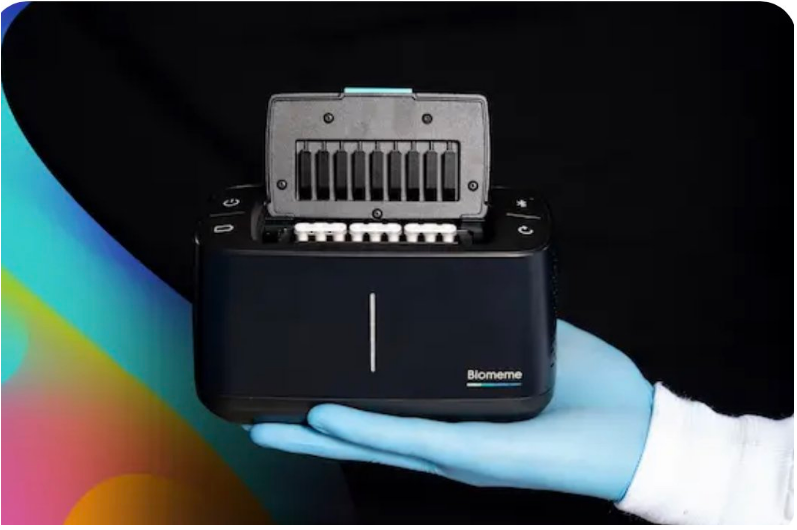Aug 22•Nzube Ekpunobi, Tunde Animashaun

Image credit: Biomeme Inc.
The future of healthcare is rapidly changing, thanks in part to advances in molecular testing, such as multiplex nucleic acid amplification tests (NAATs). Nucleic acid amplification tests (NAATs) are particularly important for organisms for which traditional tools have always been either unavailable or too expensive, such as C. trachomatis, genital mycoplasmas, and viruses. Overall, these tools overcome some important limitations of microscopy and culture-based approaches. NAATs have a significantly lower turnaround time (they can be easily automated, and the time to result is significantly lower than that of traditional approaches), they allow the detection of organisms which cannot be grown in culture, and they have a significantly higher sensitivity (a dramatically relevant advantage for asymptomatic infections where the organisms’ load is low) (Goldenberg, 2013). Furthermore, NAATs do not require viable organisms, allowing the collection and utilization of more diverse and less invasive biological samples (such as urine or vaginal swabs) which can be easily self-collected; they can be automated and standardized, and they can be performed by minimally trained people; and they can be multiplexed, allowing the detection of multiple organisms from the same sample and in a single test run (Beal et al., 2016). Due to the latest technological advances, NAATs also have significant potential to become the POC tests of the future for STIs due to a reduction in their cost (Toskin et al., 2017).
The World Health Organization (WHO) has estimated that annually approximately 374 million new cases of curable STIs such as syphilis, gonorrhoea, and chlamydia, occur worldwide in 2021 and sub-Saharan Africa accounts for approximately 40% of the global burden of STIs (WHO, 2016; Shewarega et al., 2022). Multiplex nucleic acid amplification tests (NAATs) are revolutionizing the diagnosis and treatment of sexually transmitted infections (STIs), reducing the burden of disease and saving lives. The multiplex NAATs work by amplifying and detecting multiple DNA or RNA targets simultaneously. This is done by using fluorescent probes that are specific to each target sequence. Once the targets are detected, the results are analyzed and interpreted. This can all be done in a single test, which makes it much more efficient and accurate than traditional testing methods. The ability to detect and treat co-infections with multiplex NAATs could have a major impact on reducing the burden of disease caused by STIs
One of the biggest implications of multiplex NAATs for STI diagnosis is that it can help to identify co-infections, which are when a person has more than one infection at the same time. For example, a patient may be infected with both chlamydia and gonorrhoea. If these infections are not detected and treated properly, they can lead to serious health complications. The majority of people infected with Chlamydia trachomatis/Neisseria gonorrhoeae are asymptomatic. These persons may or may not seek health care for other reasons (Wi et al., 2019). However, identifying and treating asymptomatic persons can prevent the development of STI-related complications for the individual and help reduce the transmission in the community. Nucleic acid amplification tests (NAAT) employ molecular-based technology to identify the presence of Neisseria gonorrhoea and Chlamydia trachomatisthe causative organisms of gonorrhoea and chlamydia (Tobin et al., 2020). This would reduce the time and cost of treatment, as well as the risk of complications from the infections.
In addition, multiplex NAATs could be used to develop new diagnostic tests for emerging infectious diseases. These new diagnostic tests will allow for more accurate epidemiological monitoring of the viruses causing infections, i.e. they will help to track the spread of the virus and identify areas where outbreaks are occurring. For Instance, the development of these new diagnostic tests will help to improve the overall response to Zika virus outbreaks, allowing allow for more targeted public health interventions.
Existing and newly formed NAAT technology are putting in place novel protocols with integrated sample preparation, faster amplification and detection methods, and innovative microfluidic designs to support point-of-care testing (POCT) for an array of infectious diseases and globally prevalent sexually transmitted infections (STIs). One such platform is the FRANKLIN currently developed by Biomeme. Multiplex NAATs are an important tool for improving the diagnosis and treatment of STIs, as well as emerging infectious diseases such as the Zika virus. They offer several benefits, including faster and more accurate diagnosis, improved epidemiological monitoring, and better public health interventions
References
Goldenberg, S. Molecular-based diagnostics, including future trends. Medicine 2013, 41, 663–666.
Beal, S.G.; Assarzadegan, N.; Rand, K.H. Sample-to-result molecular infectious disease assays: Clinical implications, limitations and potential. Expert Rev. Mol. Diagn. 2016, 16, 323–341.
Toskin, I.; Blondeel, K.; Peeling, R.W.; Deal, C.; Kiarie, J. Advancing point of care diagnostics for the control and prevention of STIs: The way forward. Sex. Transm. Infect.2017, 93, S81–S88
Workowski KA. Centres for Disease Control and Prevention sexually transmitted diseases treatment guidelines. Clin. Infect. Dis. 2015, 61, S759–S762.
Kejela G, Soboka B. Assessment of Knowledge, Attitude and Preventive Practices towards SexuallyTransmitted Infections among Preparatory School Students in Shone Town, Southern Ethiopia, 2014. J. Health. med. inform. 2015, 6(183), 2.
World Health Organization. Global health sector strategy on sexually transmitted infections 2016–2021: toward ending STIs. In: World Health Organization. 2016.
Shewarega, E.S., Fentie, E.A., Asmamaw, D.B. et al. Sexually transmitted infections related care-seeking behaviour and associated factors among reproductive age women in East Africa: a multilevel analysis of demographic and health surveys. BMC Public Health 2022 22, 1714 https://doi.org/10.1186/s12889-022-14120-w.
Wi TE, Ndowa FJ, Ferreyra C, Kelly-Cirino C, Taylor MM, Toskin I et al. Diagnosing sexually transmitted infections in resource-constrained settings: challenges and ways forward. J Int AIDS Soc. 2019, 22, e25343.
Tobin L, Guerra L, Ahouanvoeke L, Carpio JG, Irambona D, Nyarko EO, Macera C, Wiersma S. Is it time to use nucleic acid amplification tests for identification of persons with sexually transmitted infections?: evidence from seroprevalence and behavioural epidemiology risk surveys in men with chlamydia and gonorrhoea. Pan Afr Med J. 2020, 36, 299.